Zara's International Marketing Strategy in a Global Context
VerifiedAdded on 2020/01/28
|12
|3881
|40
Report
AI Summary
This report provides an in-depth analysis of Zara's international marketing strategy. It begins with an executive summary highlighting Zara's competitive advantages in the fashion retail market, including its ability to adapt to instant trends and offer unique products. The introduction establishes the case study's focus on Zara, a leading Spanish multinational textile company, and its use of marketing tools like PESTEL, SLEPT, and Porter's Five Forces to inform its strategic marketing plan, particularly in the context of expanding into the West African country of Ghana. The main body of the report delves into Zara's international marketing strategies, emphasizing the importance of adapting to different cultural and competitive environments. It examines the PESTEL framework (Political, Economic, Social-cultural, Technological, Environmental, and Legal factors) to assess the opportunities and threats in the Ghanaian market, including political regulations, economic conditions, socio-cultural influences on consumer behavior, and technological impacts. The report also analyzes market entry strategies, the impact of advertising, and the importance of understanding competition through Porter's Five Forces model, including barriers to entry, intensity of rivalry, threat of substitute products, and the bargaining power of buyers. The report concludes by summarizing Zara's competitive and sustainable marketing strategies, and its approach to global expansion.
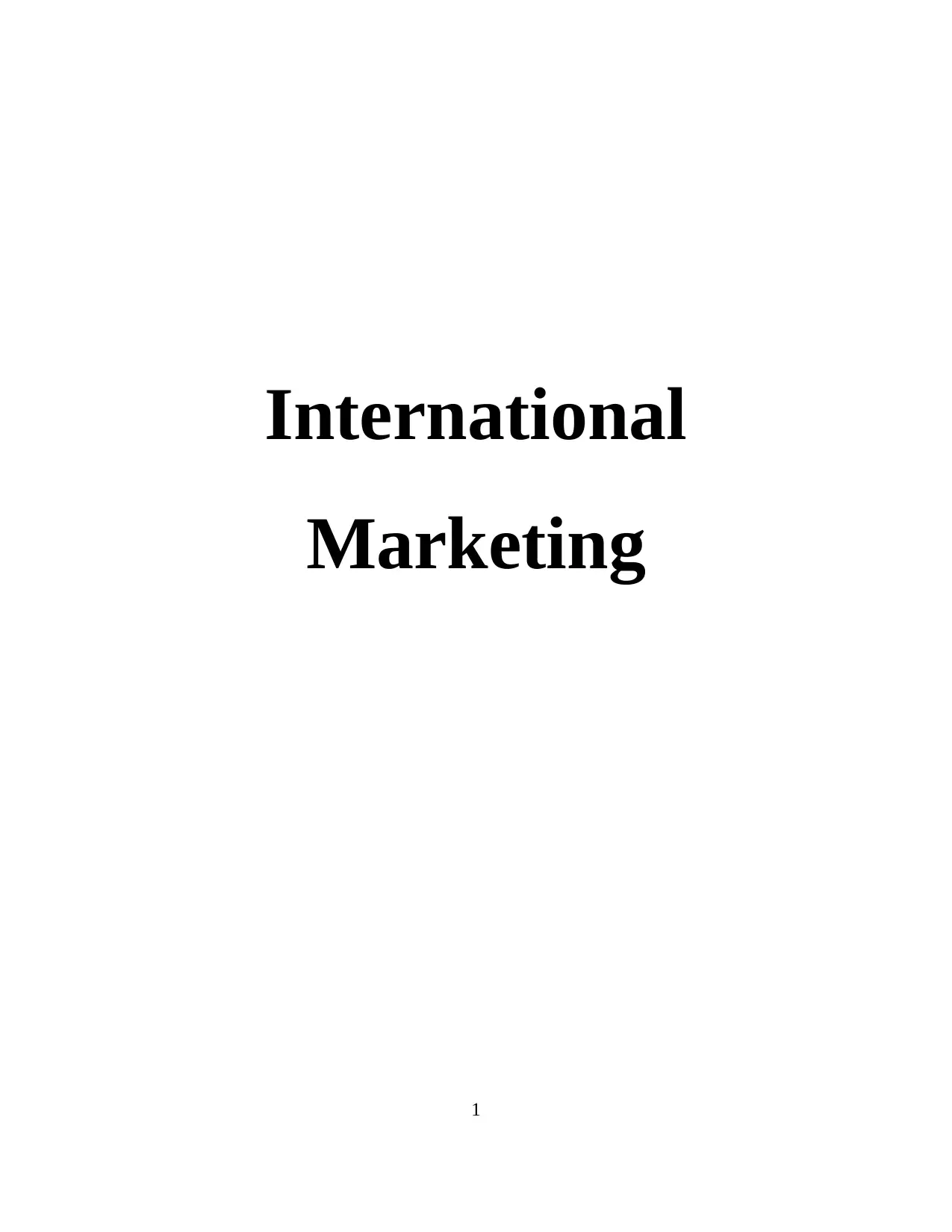
International
Marketing
1
Marketing
1
Paraphrase This Document
Need a fresh take? Get an instant paraphrase of this document with our AI Paraphraser
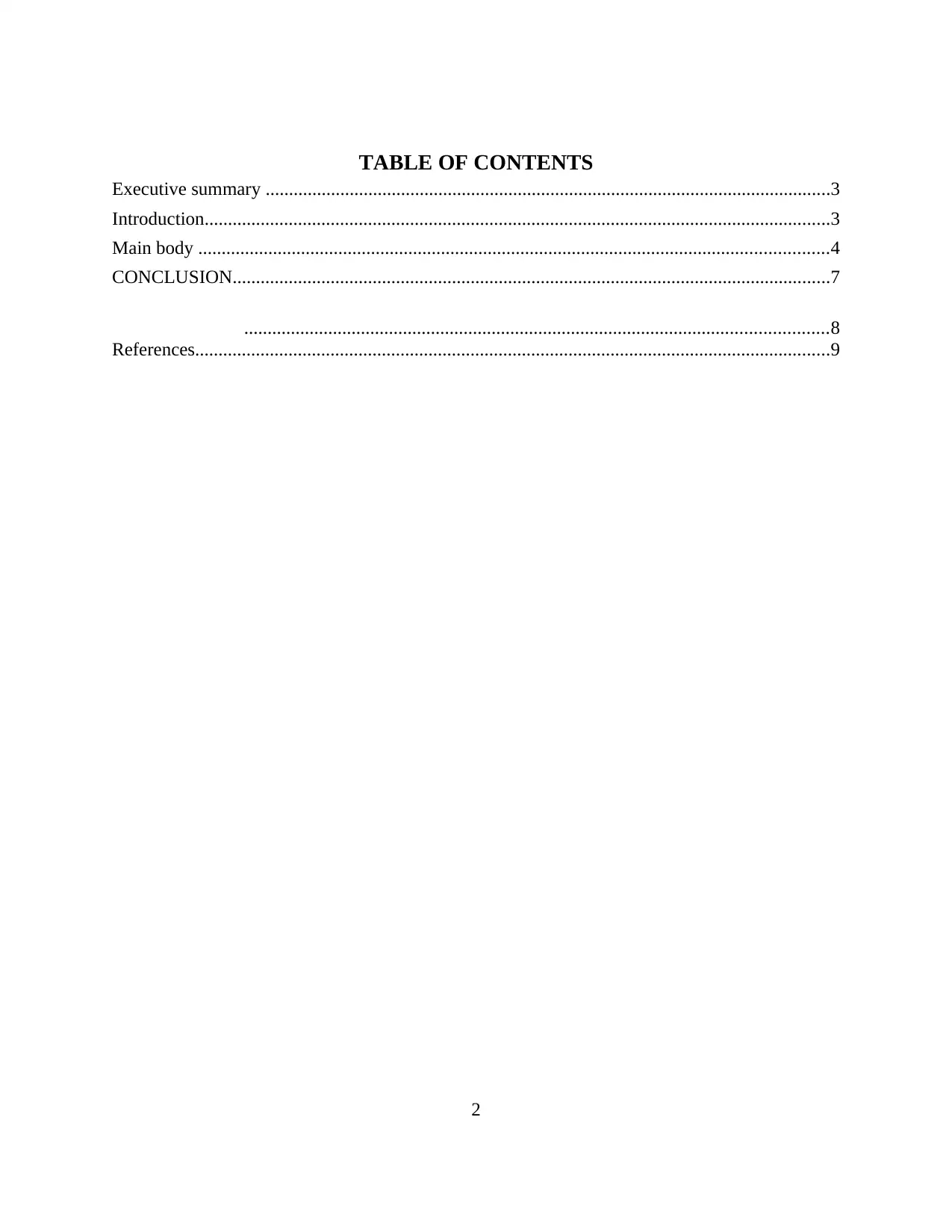
TABLE OF CONTENTS
Executive summary .........................................................................................................................3
Introduction......................................................................................................................................3
Main body .......................................................................................................................................4
CONCLUSION................................................................................................................................7
.............................................................................................................................8
References........................................................................................................................................9
2
Executive summary .........................................................................................................................3
Introduction......................................................................................................................................3
Main body .......................................................................................................................................4
CONCLUSION................................................................................................................................7
.............................................................................................................................8
References........................................................................................................................................9
2
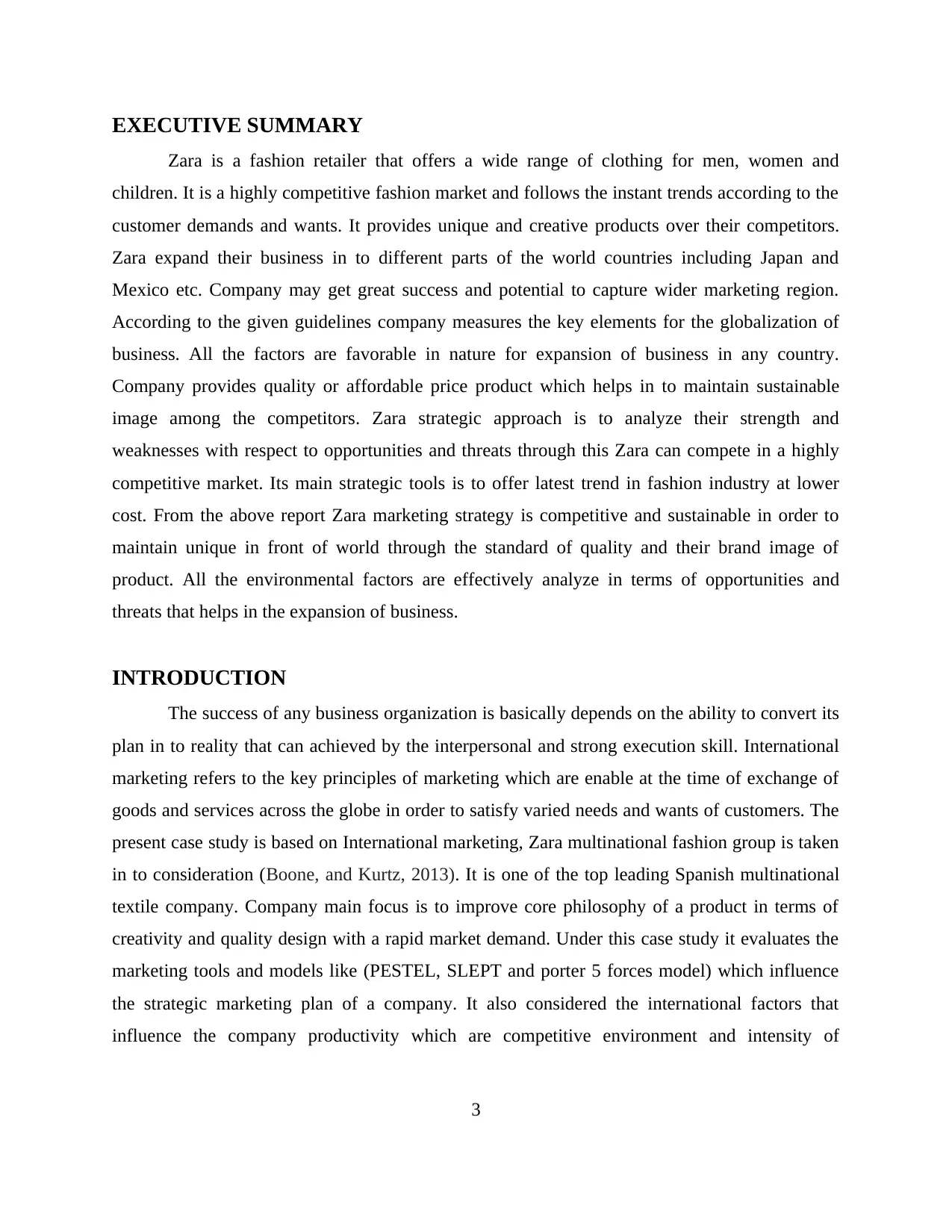
EXECUTIVE SUMMARY
Zara is a fashion retailer that offers a wide range of clothing for men, women and
children. It is a highly competitive fashion market and follows the instant trends according to the
customer demands and wants. It provides unique and creative products over their competitors.
Zara expand their business in to different parts of the world countries including Japan and
Mexico etc. Company may get great success and potential to capture wider marketing region.
According to the given guidelines company measures the key elements for the globalization of
business. All the factors are favorable in nature for expansion of business in any country.
Company provides quality or affordable price product which helps in to maintain sustainable
image among the competitors. Zara strategic approach is to analyze their strength and
weaknesses with respect to opportunities and threats through this Zara can compete in a highly
competitive market. Its main strategic tools is to offer latest trend in fashion industry at lower
cost. From the above report Zara marketing strategy is competitive and sustainable in order to
maintain unique in front of world through the standard of quality and their brand image of
product. All the environmental factors are effectively analyze in terms of opportunities and
threats that helps in the expansion of business.
INTRODUCTION
The success of any business organization is basically depends on the ability to convert its
plan in to reality that can achieved by the interpersonal and strong execution skill. International
marketing refers to the key principles of marketing which are enable at the time of exchange of
goods and services across the globe in order to satisfy varied needs and wants of customers. The
present case study is based on International marketing, Zara multinational fashion group is taken
in to consideration (Boone, and Kurtz, 2013). It is one of the top leading Spanish multinational
textile company. Company main focus is to improve core philosophy of a product in terms of
creativity and quality design with a rapid market demand. Under this case study it evaluates the
marketing tools and models like (PESTEL, SLEPT and porter 5 forces model) which influence
the strategic marketing plan of a company. It also considered the international factors that
influence the company productivity which are competitive environment and intensity of
3
Zara is a fashion retailer that offers a wide range of clothing for men, women and
children. It is a highly competitive fashion market and follows the instant trends according to the
customer demands and wants. It provides unique and creative products over their competitors.
Zara expand their business in to different parts of the world countries including Japan and
Mexico etc. Company may get great success and potential to capture wider marketing region.
According to the given guidelines company measures the key elements for the globalization of
business. All the factors are favorable in nature for expansion of business in any country.
Company provides quality or affordable price product which helps in to maintain sustainable
image among the competitors. Zara strategic approach is to analyze their strength and
weaknesses with respect to opportunities and threats through this Zara can compete in a highly
competitive market. Its main strategic tools is to offer latest trend in fashion industry at lower
cost. From the above report Zara marketing strategy is competitive and sustainable in order to
maintain unique in front of world through the standard of quality and their brand image of
product. All the environmental factors are effectively analyze in terms of opportunities and
threats that helps in the expansion of business.
INTRODUCTION
The success of any business organization is basically depends on the ability to convert its
plan in to reality that can achieved by the interpersonal and strong execution skill. International
marketing refers to the key principles of marketing which are enable at the time of exchange of
goods and services across the globe in order to satisfy varied needs and wants of customers. The
present case study is based on International marketing, Zara multinational fashion group is taken
in to consideration (Boone, and Kurtz, 2013). It is one of the top leading Spanish multinational
textile company. Company main focus is to improve core philosophy of a product in terms of
creativity and quality design with a rapid market demand. Under this case study it evaluates the
marketing tools and models like (PESTEL, SLEPT and porter 5 forces model) which influence
the strategic marketing plan of a company. It also considered the international factors that
influence the company productivity which are competitive environment and intensity of
3
⊘ This is a preview!⊘
Do you want full access?
Subscribe today to unlock all pages.

Trusted by 1+ million students worldwide
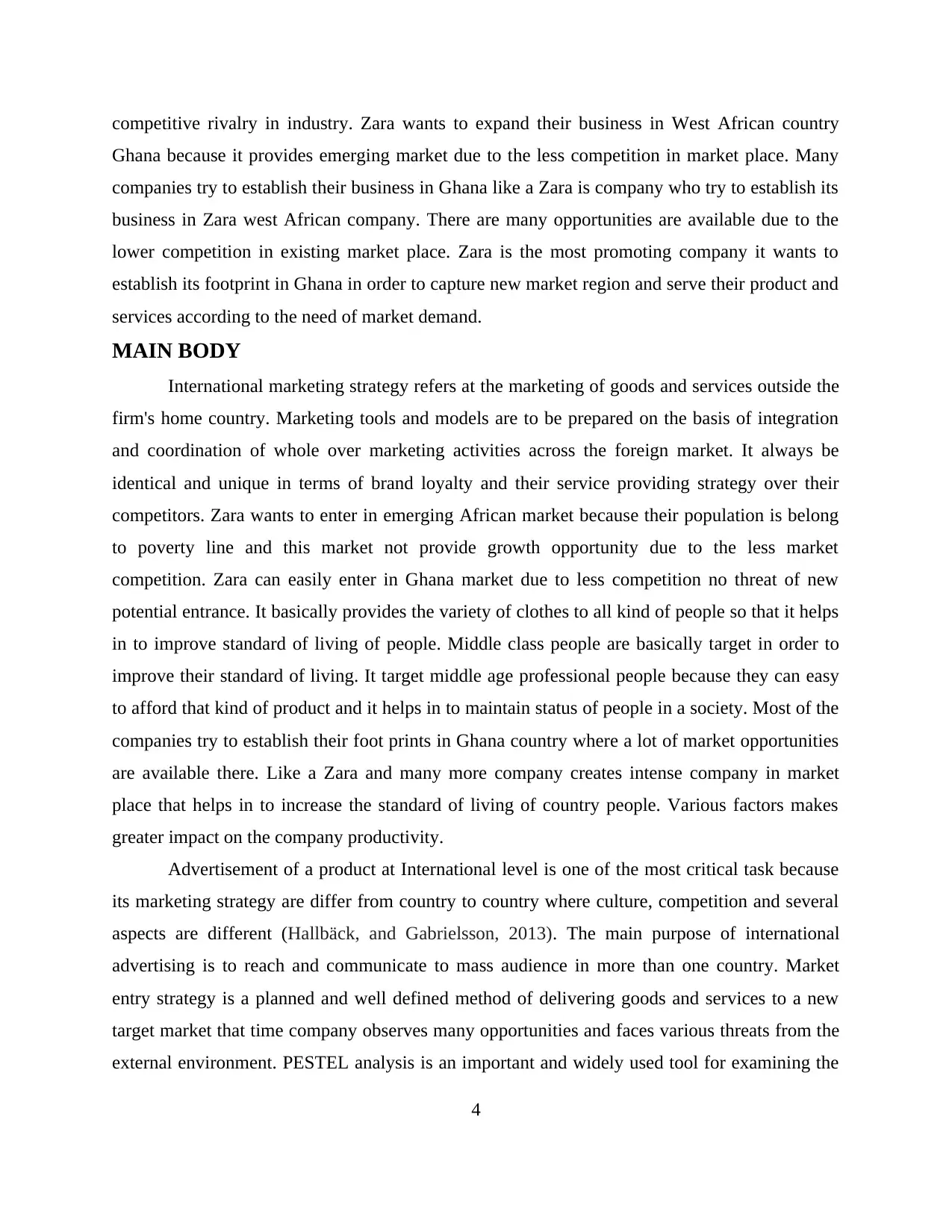
competitive rivalry in industry. Zara wants to expand their business in West African country
Ghana because it provides emerging market due to the less competition in market place. Many
companies try to establish their business in Ghana like a Zara is company who try to establish its
business in Zara west African company. There are many opportunities are available due to the
lower competition in existing market place. Zara is the most promoting company it wants to
establish its footprint in Ghana in order to capture new market region and serve their product and
services according to the need of market demand.
MAIN BODY
International marketing strategy refers at the marketing of goods and services outside the
firm's home country. Marketing tools and models are to be prepared on the basis of integration
and coordination of whole over marketing activities across the foreign market. It always be
identical and unique in terms of brand loyalty and their service providing strategy over their
competitors. Zara wants to enter in emerging African market because their population is belong
to poverty line and this market not provide growth opportunity due to the less market
competition. Zara can easily enter in Ghana market due to less competition no threat of new
potential entrance. It basically provides the variety of clothes to all kind of people so that it helps
in to improve standard of living of people. Middle class people are basically target in order to
improve their standard of living. It target middle age professional people because they can easy
to afford that kind of product and it helps in to maintain status of people in a society. Most of the
companies try to establish their foot prints in Ghana country where a lot of market opportunities
are available there. Like a Zara and many more company creates intense company in market
place that helps in to increase the standard of living of country people. Various factors makes
greater impact on the company productivity.
Advertisement of a product at International level is one of the most critical task because
its marketing strategy are differ from country to country where culture, competition and several
aspects are different (Hallbäck, and Gabrielsson, 2013). The main purpose of international
advertising is to reach and communicate to mass audience in more than one country. Market
entry strategy is a planned and well defined method of delivering goods and services to a new
target market that time company observes many opportunities and faces various threats from the
external environment. PESTEL analysis is an important and widely used tool for examining the
4
Ghana because it provides emerging market due to the less competition in market place. Many
companies try to establish their business in Ghana like a Zara is company who try to establish its
business in Zara west African company. There are many opportunities are available due to the
lower competition in existing market place. Zara is the most promoting company it wants to
establish its footprint in Ghana in order to capture new market region and serve their product and
services according to the need of market demand.
MAIN BODY
International marketing strategy refers at the marketing of goods and services outside the
firm's home country. Marketing tools and models are to be prepared on the basis of integration
and coordination of whole over marketing activities across the foreign market. It always be
identical and unique in terms of brand loyalty and their service providing strategy over their
competitors. Zara wants to enter in emerging African market because their population is belong
to poverty line and this market not provide growth opportunity due to the less market
competition. Zara can easily enter in Ghana market due to less competition no threat of new
potential entrance. It basically provides the variety of clothes to all kind of people so that it helps
in to improve standard of living of people. Middle class people are basically target in order to
improve their standard of living. It target middle age professional people because they can easy
to afford that kind of product and it helps in to maintain status of people in a society. Most of the
companies try to establish their foot prints in Ghana country where a lot of market opportunities
are available there. Like a Zara and many more company creates intense company in market
place that helps in to increase the standard of living of country people. Various factors makes
greater impact on the company productivity.
Advertisement of a product at International level is one of the most critical task because
its marketing strategy are differ from country to country where culture, competition and several
aspects are different (Hallbäck, and Gabrielsson, 2013). The main purpose of international
advertising is to reach and communicate to mass audience in more than one country. Market
entry strategy is a planned and well defined method of delivering goods and services to a new
target market that time company observes many opportunities and faces various threats from the
external environment. PESTEL analysis is an important and widely used tool for examining the
4
Paraphrase This Document
Need a fresh take? Get an instant paraphrase of this document with our AI Paraphraser
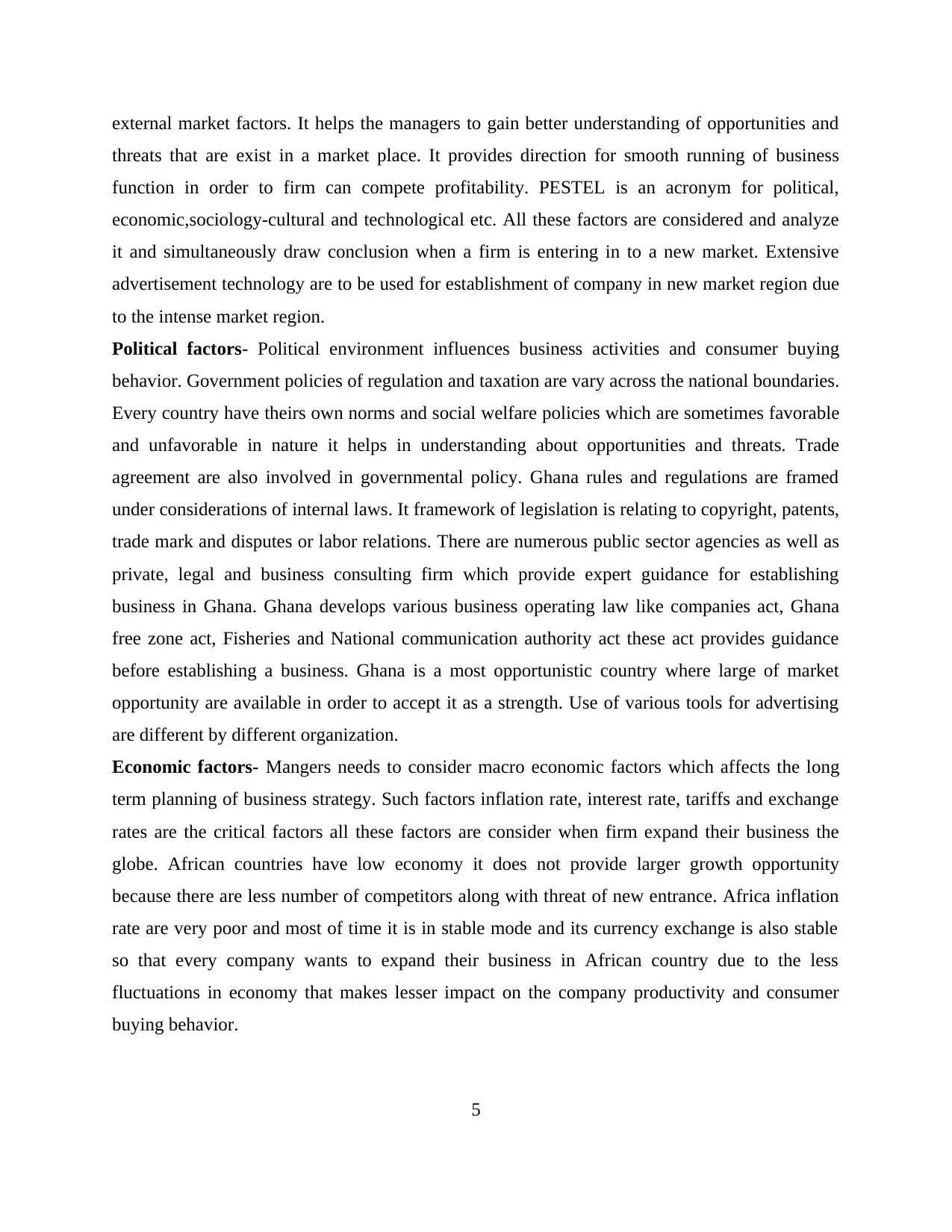
external market factors. It helps the managers to gain better understanding of opportunities and
threats that are exist in a market place. It provides direction for smooth running of business
function in order to firm can compete profitability. PESTEL is an acronym for political,
economic,sociology-cultural and technological etc. All these factors are considered and analyze
it and simultaneously draw conclusion when a firm is entering in to a new market. Extensive
advertisement technology are to be used for establishment of company in new market region due
to the intense market region.
Political factors- Political environment influences business activities and consumer buying
behavior. Government policies of regulation and taxation are vary across the national boundaries.
Every country have theirs own norms and social welfare policies which are sometimes favorable
and unfavorable in nature it helps in understanding about opportunities and threats. Trade
agreement are also involved in governmental policy. Ghana rules and regulations are framed
under considerations of internal laws. It framework of legislation is relating to copyright, patents,
trade mark and disputes or labor relations. There are numerous public sector agencies as well as
private, legal and business consulting firm which provide expert guidance for establishing
business in Ghana. Ghana develops various business operating law like companies act, Ghana
free zone act, Fisheries and National communication authority act these act provides guidance
before establishing a business. Ghana is a most opportunistic country where large of market
opportunity are available in order to accept it as a strength. Use of various tools for advertising
are different by different organization.
Economic factors- Mangers needs to consider macro economic factors which affects the long
term planning of business strategy. Such factors inflation rate, interest rate, tariffs and exchange
rates are the critical factors all these factors are consider when firm expand their business the
globe. African countries have low economy it does not provide larger growth opportunity
because there are less number of competitors along with threat of new entrance. Africa inflation
rate are very poor and most of time it is in stable mode and its currency exchange is also stable
so that every company wants to expand their business in African country due to the less
fluctuations in economy that makes lesser impact on the company productivity and consumer
buying behavior.
5
threats that are exist in a market place. It provides direction for smooth running of business
function in order to firm can compete profitability. PESTEL is an acronym for political,
economic,sociology-cultural and technological etc. All these factors are considered and analyze
it and simultaneously draw conclusion when a firm is entering in to a new market. Extensive
advertisement technology are to be used for establishment of company in new market region due
to the intense market region.
Political factors- Political environment influences business activities and consumer buying
behavior. Government policies of regulation and taxation are vary across the national boundaries.
Every country have theirs own norms and social welfare policies which are sometimes favorable
and unfavorable in nature it helps in understanding about opportunities and threats. Trade
agreement are also involved in governmental policy. Ghana rules and regulations are framed
under considerations of internal laws. It framework of legislation is relating to copyright, patents,
trade mark and disputes or labor relations. There are numerous public sector agencies as well as
private, legal and business consulting firm which provide expert guidance for establishing
business in Ghana. Ghana develops various business operating law like companies act, Ghana
free zone act, Fisheries and National communication authority act these act provides guidance
before establishing a business. Ghana is a most opportunistic country where large of market
opportunity are available in order to accept it as a strength. Use of various tools for advertising
are different by different organization.
Economic factors- Mangers needs to consider macro economic factors which affects the long
term planning of business strategy. Such factors inflation rate, interest rate, tariffs and exchange
rates are the critical factors all these factors are consider when firm expand their business the
globe. African countries have low economy it does not provide larger growth opportunity
because there are less number of competitors along with threat of new entrance. Africa inflation
rate are very poor and most of time it is in stable mode and its currency exchange is also stable
so that every company wants to expand their business in African country due to the less
fluctuations in economy that makes lesser impact on the company productivity and consumer
buying behavior.
5
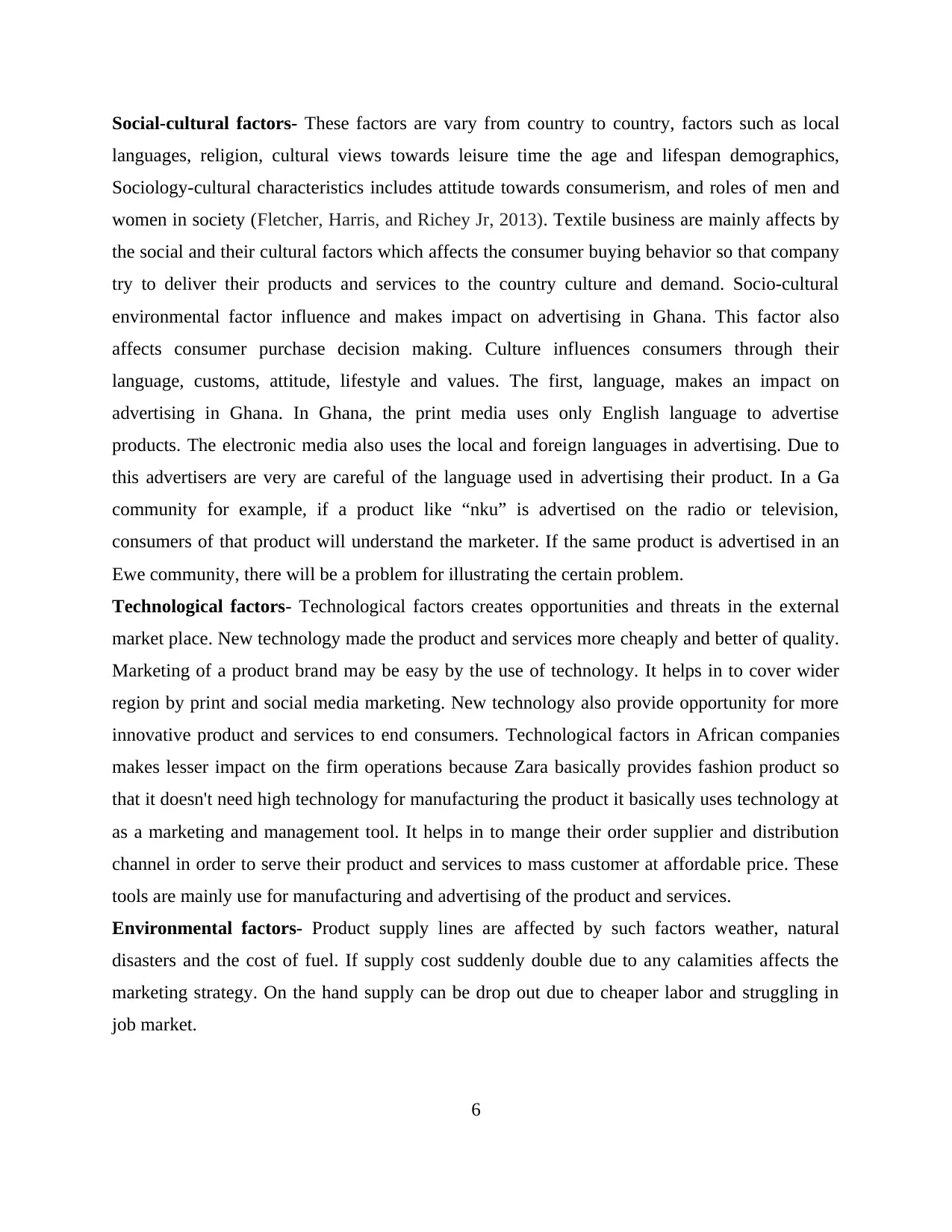
Social-cultural factors- These factors are vary from country to country, factors such as local
languages, religion, cultural views towards leisure time the age and lifespan demographics,
Sociology-cultural characteristics includes attitude towards consumerism, and roles of men and
women in society (Fletcher, Harris, and Richey Jr, 2013). Textile business are mainly affects by
the social and their cultural factors which affects the consumer buying behavior so that company
try to deliver their products and services to the country culture and demand. Socio-cultural
environmental factor influence and makes impact on advertising in Ghana. This factor also
affects consumer purchase decision making. Culture influences consumers through their
language, customs, attitude, lifestyle and values. The first, language, makes an impact on
advertising in Ghana. In Ghana, the print media uses only English language to advertise
products. The electronic media also uses the local and foreign languages in advertising. Due to
this advertisers are very are careful of the language used in advertising their product. In a Ga
community for example, if a product like “nku” is advertised on the radio or television,
consumers of that product will understand the marketer. If the same product is advertised in an
Ewe community, there will be a problem for illustrating the certain problem.
Technological factors- Technological factors creates opportunities and threats in the external
market place. New technology made the product and services more cheaply and better of quality.
Marketing of a product brand may be easy by the use of technology. It helps in to cover wider
region by print and social media marketing. New technology also provide opportunity for more
innovative product and services to end consumers. Technological factors in African companies
makes lesser impact on the firm operations because Zara basically provides fashion product so
that it doesn't need high technology for manufacturing the product it basically uses technology at
as a marketing and management tool. It helps in to mange their order supplier and distribution
channel in order to serve their product and services to mass customer at affordable price. These
tools are mainly use for manufacturing and advertising of the product and services.
Environmental factors- Product supply lines are affected by such factors weather, natural
disasters and the cost of fuel. If supply cost suddenly double due to any calamities affects the
marketing strategy. On the hand supply can be drop out due to cheaper labor and struggling in
job market.
6
languages, religion, cultural views towards leisure time the age and lifespan demographics,
Sociology-cultural characteristics includes attitude towards consumerism, and roles of men and
women in society (Fletcher, Harris, and Richey Jr, 2013). Textile business are mainly affects by
the social and their cultural factors which affects the consumer buying behavior so that company
try to deliver their products and services to the country culture and demand. Socio-cultural
environmental factor influence and makes impact on advertising in Ghana. This factor also
affects consumer purchase decision making. Culture influences consumers through their
language, customs, attitude, lifestyle and values. The first, language, makes an impact on
advertising in Ghana. In Ghana, the print media uses only English language to advertise
products. The electronic media also uses the local and foreign languages in advertising. Due to
this advertisers are very are careful of the language used in advertising their product. In a Ga
community for example, if a product like “nku” is advertised on the radio or television,
consumers of that product will understand the marketer. If the same product is advertised in an
Ewe community, there will be a problem for illustrating the certain problem.
Technological factors- Technological factors creates opportunities and threats in the external
market place. New technology made the product and services more cheaply and better of quality.
Marketing of a product brand may be easy by the use of technology. It helps in to cover wider
region by print and social media marketing. New technology also provide opportunity for more
innovative product and services to end consumers. Technological factors in African companies
makes lesser impact on the firm operations because Zara basically provides fashion product so
that it doesn't need high technology for manufacturing the product it basically uses technology at
as a marketing and management tool. It helps in to mange their order supplier and distribution
channel in order to serve their product and services to mass customer at affordable price. These
tools are mainly use for manufacturing and advertising of the product and services.
Environmental factors- Product supply lines are affected by such factors weather, natural
disasters and the cost of fuel. If supply cost suddenly double due to any calamities affects the
marketing strategy. On the hand supply can be drop out due to cheaper labor and struggling in
job market.
6
⊘ This is a preview!⊘
Do you want full access?
Subscribe today to unlock all pages.

Trusted by 1+ million students worldwide
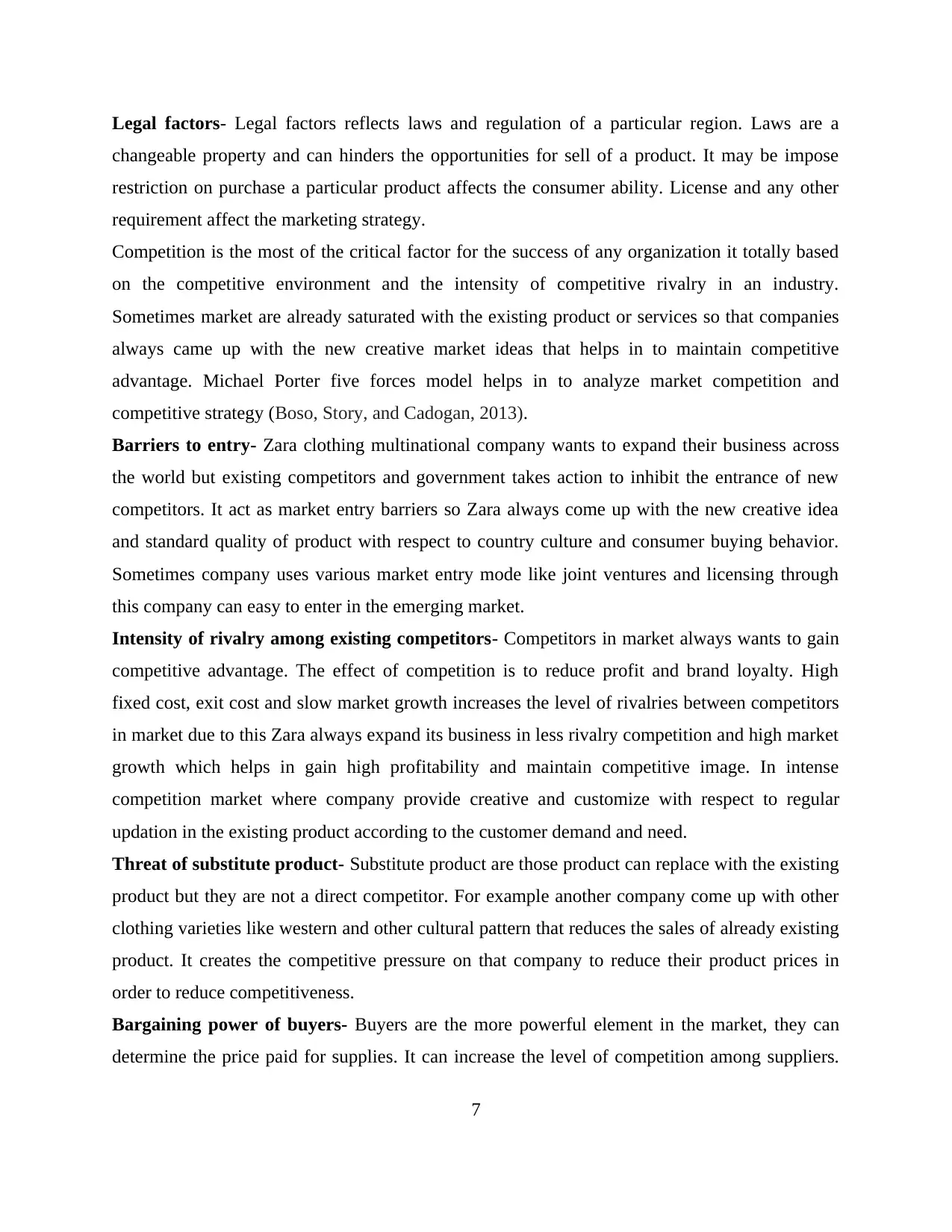
Legal factors- Legal factors reflects laws and regulation of a particular region. Laws are a
changeable property and can hinders the opportunities for sell of a product. It may be impose
restriction on purchase a particular product affects the consumer ability. License and any other
requirement affect the marketing strategy.
Competition is the most of the critical factor for the success of any organization it totally based
on the competitive environment and the intensity of competitive rivalry in an industry.
Sometimes market are already saturated with the existing product or services so that companies
always came up with the new creative market ideas that helps in to maintain competitive
advantage. Michael Porter five forces model helps in to analyze market competition and
competitive strategy (Boso, Story, and Cadogan, 2013).
Barriers to entry- Zara clothing multinational company wants to expand their business across
the world but existing competitors and government takes action to inhibit the entrance of new
competitors. It act as market entry barriers so Zara always come up with the new creative idea
and standard quality of product with respect to country culture and consumer buying behavior.
Sometimes company uses various market entry mode like joint ventures and licensing through
this company can easy to enter in the emerging market.
Intensity of rivalry among existing competitors- Competitors in market always wants to gain
competitive advantage. The effect of competition is to reduce profit and brand loyalty. High
fixed cost, exit cost and slow market growth increases the level of rivalries between competitors
in market due to this Zara always expand its business in less rivalry competition and high market
growth which helps in gain high profitability and maintain competitive image. In intense
competition market where company provide creative and customize with respect to regular
updation in the existing product according to the customer demand and need.
Threat of substitute product- Substitute product are those product can replace with the existing
product but they are not a direct competitor. For example another company come up with other
clothing varieties like western and other cultural pattern that reduces the sales of already existing
product. It creates the competitive pressure on that company to reduce their product prices in
order to reduce competitiveness.
Bargaining power of buyers- Buyers are the more powerful element in the market, they can
determine the price paid for supplies. It can increase the level of competition among suppliers.
7
changeable property and can hinders the opportunities for sell of a product. It may be impose
restriction on purchase a particular product affects the consumer ability. License and any other
requirement affect the marketing strategy.
Competition is the most of the critical factor for the success of any organization it totally based
on the competitive environment and the intensity of competitive rivalry in an industry.
Sometimes market are already saturated with the existing product or services so that companies
always came up with the new creative market ideas that helps in to maintain competitive
advantage. Michael Porter five forces model helps in to analyze market competition and
competitive strategy (Boso, Story, and Cadogan, 2013).
Barriers to entry- Zara clothing multinational company wants to expand their business across
the world but existing competitors and government takes action to inhibit the entrance of new
competitors. It act as market entry barriers so Zara always come up with the new creative idea
and standard quality of product with respect to country culture and consumer buying behavior.
Sometimes company uses various market entry mode like joint ventures and licensing through
this company can easy to enter in the emerging market.
Intensity of rivalry among existing competitors- Competitors in market always wants to gain
competitive advantage. The effect of competition is to reduce profit and brand loyalty. High
fixed cost, exit cost and slow market growth increases the level of rivalries between competitors
in market due to this Zara always expand its business in less rivalry competition and high market
growth which helps in gain high profitability and maintain competitive image. In intense
competition market where company provide creative and customize with respect to regular
updation in the existing product according to the customer demand and need.
Threat of substitute product- Substitute product are those product can replace with the existing
product but they are not a direct competitor. For example another company come up with other
clothing varieties like western and other cultural pattern that reduces the sales of already existing
product. It creates the competitive pressure on that company to reduce their product prices in
order to reduce competitiveness.
Bargaining power of buyers- Buyers are the more powerful element in the market, they can
determine the price paid for supplies. It can increase the level of competition among suppliers.
7
Paraphrase This Document
Need a fresh take? Get an instant paraphrase of this document with our AI Paraphraser
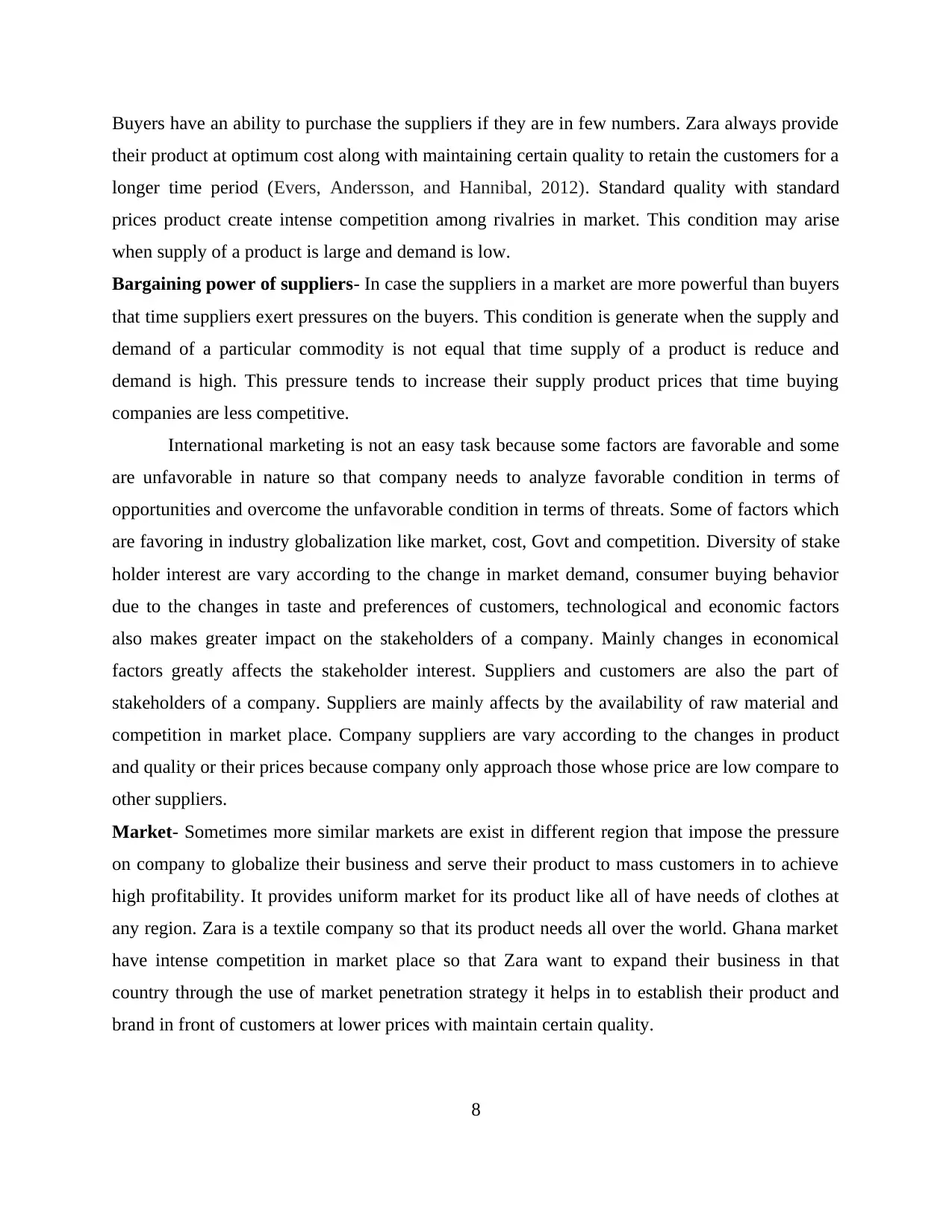
Buyers have an ability to purchase the suppliers if they are in few numbers. Zara always provide
their product at optimum cost along with maintaining certain quality to retain the customers for a
longer time period (Evers, Andersson, and Hannibal, 2012). Standard quality with standard
prices product create intense competition among rivalries in market. This condition may arise
when supply of a product is large and demand is low.
Bargaining power of suppliers- In case the suppliers in a market are more powerful than buyers
that time suppliers exert pressures on the buyers. This condition is generate when the supply and
demand of a particular commodity is not equal that time supply of a product is reduce and
demand is high. This pressure tends to increase their supply product prices that time buying
companies are less competitive.
International marketing is not an easy task because some factors are favorable and some
are unfavorable in nature so that company needs to analyze favorable condition in terms of
opportunities and overcome the unfavorable condition in terms of threats. Some of factors which
are favoring in industry globalization like market, cost, Govt and competition. Diversity of stake
holder interest are vary according to the change in market demand, consumer buying behavior
due to the changes in taste and preferences of customers, technological and economic factors
also makes greater impact on the stakeholders of a company. Mainly changes in economical
factors greatly affects the stakeholder interest. Suppliers and customers are also the part of
stakeholders of a company. Suppliers are mainly affects by the availability of raw material and
competition in market place. Company suppliers are vary according to the changes in product
and quality or their prices because company only approach those whose price are low compare to
other suppliers.
Market- Sometimes more similar markets are exist in different region that impose the pressure
on company to globalize their business and serve their product to mass customers in to achieve
high profitability. It provides uniform market for its product like all of have needs of clothes at
any region. Zara is a textile company so that its product needs all over the world. Ghana market
have intense competition in market place so that Zara want to expand their business in that
country through the use of market penetration strategy it helps in to establish their product and
brand in front of customers at lower prices with maintain certain quality.
8
their product at optimum cost along with maintaining certain quality to retain the customers for a
longer time period (Evers, Andersson, and Hannibal, 2012). Standard quality with standard
prices product create intense competition among rivalries in market. This condition may arise
when supply of a product is large and demand is low.
Bargaining power of suppliers- In case the suppliers in a market are more powerful than buyers
that time suppliers exert pressures on the buyers. This condition is generate when the supply and
demand of a particular commodity is not equal that time supply of a product is reduce and
demand is high. This pressure tends to increase their supply product prices that time buying
companies are less competitive.
International marketing is not an easy task because some factors are favorable and some
are unfavorable in nature so that company needs to analyze favorable condition in terms of
opportunities and overcome the unfavorable condition in terms of threats. Some of factors which
are favoring in industry globalization like market, cost, Govt and competition. Diversity of stake
holder interest are vary according to the change in market demand, consumer buying behavior
due to the changes in taste and preferences of customers, technological and economic factors
also makes greater impact on the stakeholders of a company. Mainly changes in economical
factors greatly affects the stakeholder interest. Suppliers and customers are also the part of
stakeholders of a company. Suppliers are mainly affects by the availability of raw material and
competition in market place. Company suppliers are vary according to the changes in product
and quality or their prices because company only approach those whose price are low compare to
other suppliers.
Market- Sometimes more similar markets are exist in different region that impose the pressure
on company to globalize their business and serve their product to mass customers in to achieve
high profitability. It provides uniform market for its product like all of have needs of clothes at
any region. Zara is a textile company so that its product needs all over the world. Ghana market
have intense competition in market place so that Zara want to expand their business in that
country through the use of market penetration strategy it helps in to establish their product and
brand in front of customers at lower prices with maintain certain quality.
8
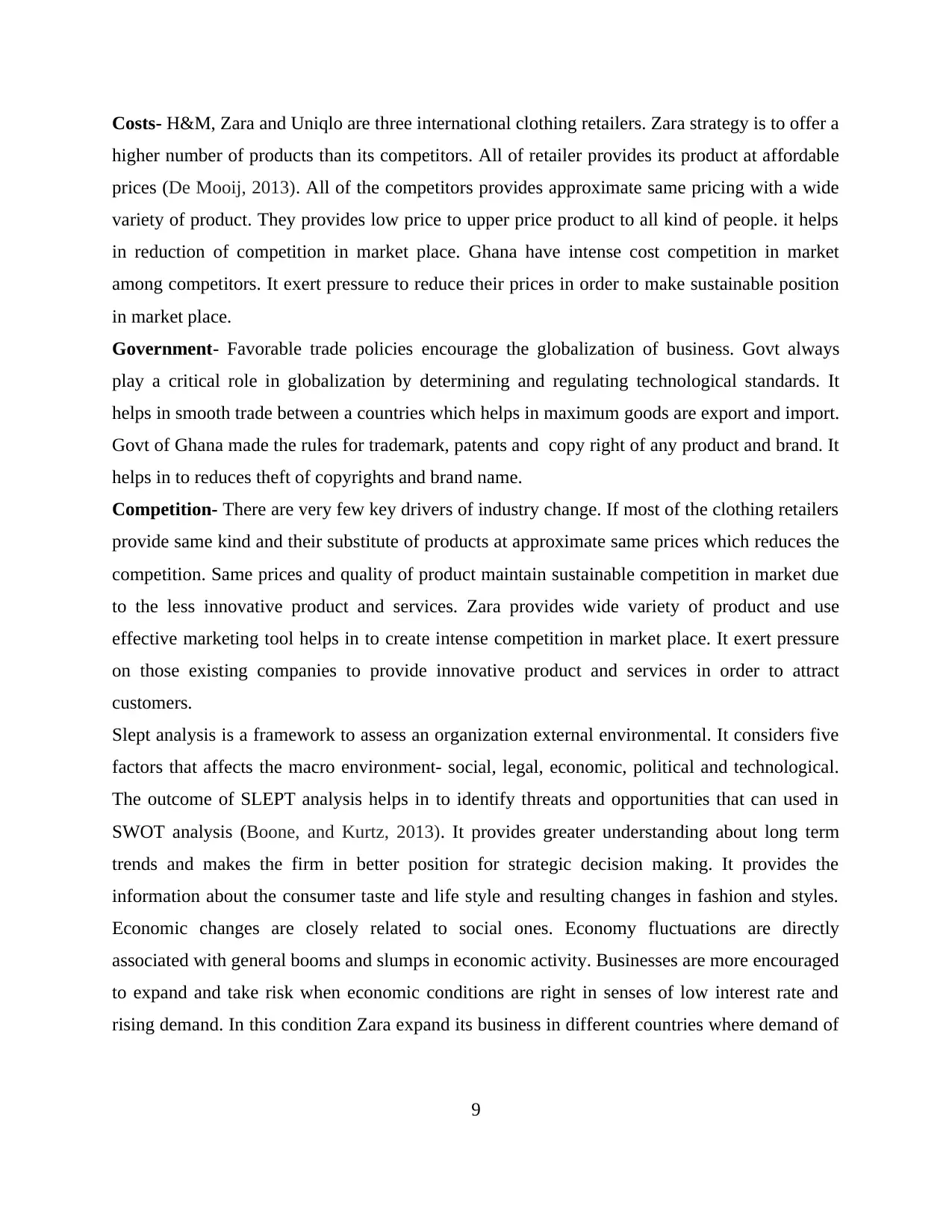
Costs- H&M, Zara and Uniqlo are three international clothing retailers. Zara strategy is to offer a
higher number of products than its competitors. All of retailer provides its product at affordable
prices (De Mooij, 2013). All of the competitors provides approximate same pricing with a wide
variety of product. They provides low price to upper price product to all kind of people. it helps
in reduction of competition in market place. Ghana have intense cost competition in market
among competitors. It exert pressure to reduce their prices in order to make sustainable position
in market place.
Government- Favorable trade policies encourage the globalization of business. Govt always
play a critical role in globalization by determining and regulating technological standards. It
helps in smooth trade between a countries which helps in maximum goods are export and import.
Govt of Ghana made the rules for trademark, patents and copy right of any product and brand. It
helps in to reduces theft of copyrights and brand name.
Competition- There are very few key drivers of industry change. If most of the clothing retailers
provide same kind and their substitute of products at approximate same prices which reduces the
competition. Same prices and quality of product maintain sustainable competition in market due
to the less innovative product and services. Zara provides wide variety of product and use
effective marketing tool helps in to create intense competition in market place. It exert pressure
on those existing companies to provide innovative product and services in order to attract
customers.
Slept analysis is a framework to assess an organization external environmental. It considers five
factors that affects the macro environment- social, legal, economic, political and technological.
The outcome of SLEPT analysis helps in to identify threats and opportunities that can used in
SWOT analysis (Boone, and Kurtz, 2013). It provides greater understanding about long term
trends and makes the firm in better position for strategic decision making. It provides the
information about the consumer taste and life style and resulting changes in fashion and styles.
Economic changes are closely related to social ones. Economy fluctuations are directly
associated with general booms and slumps in economic activity. Businesses are more encouraged
to expand and take risk when economic conditions are right in senses of low interest rate and
rising demand. In this condition Zara expand its business in different countries where demand of
9
higher number of products than its competitors. All of retailer provides its product at affordable
prices (De Mooij, 2013). All of the competitors provides approximate same pricing with a wide
variety of product. They provides low price to upper price product to all kind of people. it helps
in reduction of competition in market place. Ghana have intense cost competition in market
among competitors. It exert pressure to reduce their prices in order to make sustainable position
in market place.
Government- Favorable trade policies encourage the globalization of business. Govt always
play a critical role in globalization by determining and regulating technological standards. It
helps in smooth trade between a countries which helps in maximum goods are export and import.
Govt of Ghana made the rules for trademark, patents and copy right of any product and brand. It
helps in to reduces theft of copyrights and brand name.
Competition- There are very few key drivers of industry change. If most of the clothing retailers
provide same kind and their substitute of products at approximate same prices which reduces the
competition. Same prices and quality of product maintain sustainable competition in market due
to the less innovative product and services. Zara provides wide variety of product and use
effective marketing tool helps in to create intense competition in market place. It exert pressure
on those existing companies to provide innovative product and services in order to attract
customers.
Slept analysis is a framework to assess an organization external environmental. It considers five
factors that affects the macro environment- social, legal, economic, political and technological.
The outcome of SLEPT analysis helps in to identify threats and opportunities that can used in
SWOT analysis (Boone, and Kurtz, 2013). It provides greater understanding about long term
trends and makes the firm in better position for strategic decision making. It provides the
information about the consumer taste and life style and resulting changes in fashion and styles.
Economic changes are closely related to social ones. Economy fluctuations are directly
associated with general booms and slumps in economic activity. Businesses are more encouraged
to expand and take risk when economic conditions are right in senses of low interest rate and
rising demand. In this condition Zara expand its business in different countries where demand of
9
⊘ This is a preview!⊘
Do you want full access?
Subscribe today to unlock all pages.

Trusted by 1+ million students worldwide
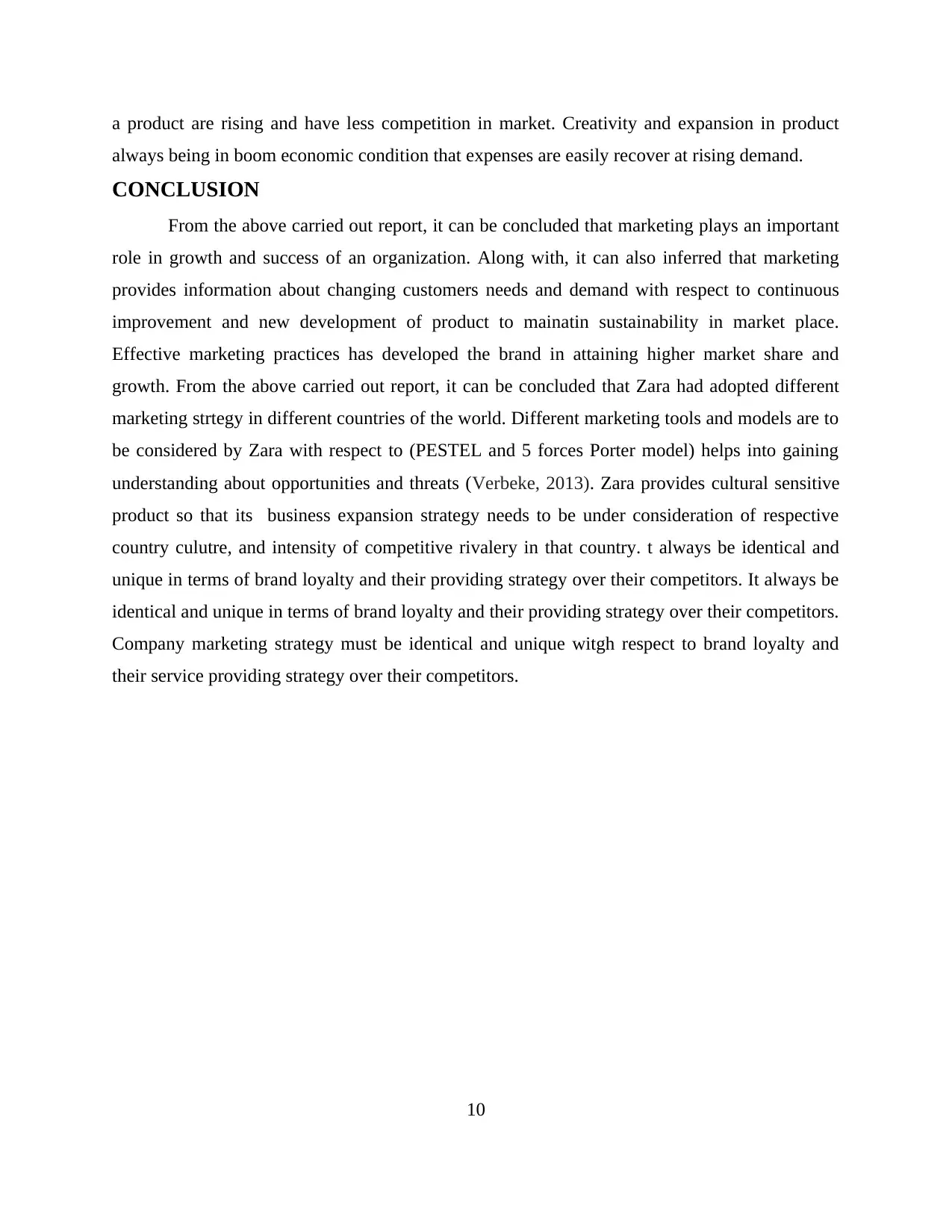
a product are rising and have less competition in market. Creativity and expansion in product
always being in boom economic condition that expenses are easily recover at rising demand.
CONCLUSION
From the above carried out report, it can be concluded that marketing plays an important
role in growth and success of an organization. Along with, it can also inferred that marketing
provides information about changing customers needs and demand with respect to continuous
improvement and new development of product to mainatin sustainability in market place.
Effective marketing practices has developed the brand in attaining higher market share and
growth. From the above carried out report, it can be concluded that Zara had adopted different
marketing strtegy in different countries of the world. Different marketing tools and models are to
be considered by Zara with respect to (PESTEL and 5 forces Porter model) helps into gaining
understanding about opportunities and threats (Verbeke, 2013). Zara provides cultural sensitive
product so that its business expansion strategy needs to be under consideration of respective
country culutre, and intensity of competitive rivalery in that country. t always be identical and
unique in terms of brand loyalty and their providing strategy over their competitors. It always be
identical and unique in terms of brand loyalty and their providing strategy over their competitors.
Company marketing strategy must be identical and unique witgh respect to brand loyalty and
their service providing strategy over their competitors.
10
always being in boom economic condition that expenses are easily recover at rising demand.
CONCLUSION
From the above carried out report, it can be concluded that marketing plays an important
role in growth and success of an organization. Along with, it can also inferred that marketing
provides information about changing customers needs and demand with respect to continuous
improvement and new development of product to mainatin sustainability in market place.
Effective marketing practices has developed the brand in attaining higher market share and
growth. From the above carried out report, it can be concluded that Zara had adopted different
marketing strtegy in different countries of the world. Different marketing tools and models are to
be considered by Zara with respect to (PESTEL and 5 forces Porter model) helps into gaining
understanding about opportunities and threats (Verbeke, 2013). Zara provides cultural sensitive
product so that its business expansion strategy needs to be under consideration of respective
country culutre, and intensity of competitive rivalery in that country. t always be identical and
unique in terms of brand loyalty and their providing strategy over their competitors. It always be
identical and unique in terms of brand loyalty and their providing strategy over their competitors.
Company marketing strategy must be identical and unique witgh respect to brand loyalty and
their service providing strategy over their competitors.
10
Paraphrase This Document
Need a fresh take? Get an instant paraphrase of this document with our AI Paraphraser
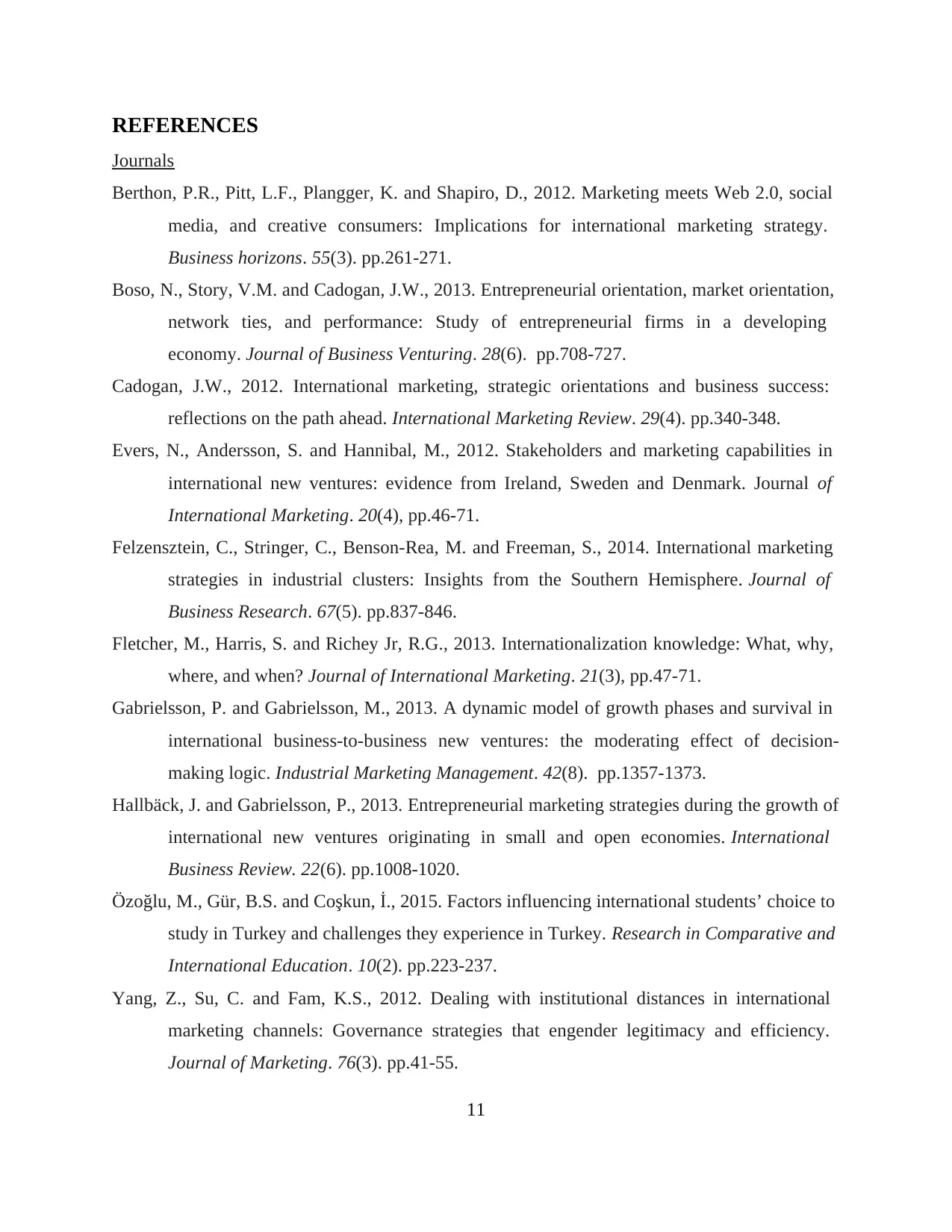
REFERENCES
Journals
Berthon, P.R., Pitt, L.F., Plangger, K. and Shapiro, D., 2012. Marketing meets Web 2.0, social
media, and creative consumers: Implications for international marketing strategy.
Business horizons. 55(3). pp.261-271.
Boso, N., Story, V.M. and Cadogan, J.W., 2013. Entrepreneurial orientation, market orientation,
network ties, and performance: Study of entrepreneurial firms in a developing
economy. Journal of Business Venturing. 28(6). pp.708-727.
Cadogan, J.W., 2012. International marketing, strategic orientations and business success:
reflections on the path ahead. International Marketing Review. 29(4). pp.340-348.
Evers, N., Andersson, S. and Hannibal, M., 2012. Stakeholders and marketing capabilities in
international new ventures: evidence from Ireland, Sweden and Denmark. Journal of
International Marketing. 20(4), pp.46-71.
Felzensztein, C., Stringer, C., Benson-Rea, M. and Freeman, S., 2014. International marketing
strategies in industrial clusters: Insights from the Southern Hemisphere. Journal of
Business Research. 67(5). pp.837-846.
Fletcher, M., Harris, S. and Richey Jr, R.G., 2013. Internationalization knowledge: What, why,
where, and when? Journal of International Marketing. 21(3), pp.47-71.
Gabrielsson, P. and Gabrielsson, M., 2013. A dynamic model of growth phases and survival in
international business-to-business new ventures: the moderating effect of decision-
making logic. Industrial Marketing Management. 42(8). pp.1357-1373.
Hallbäck, J. and Gabrielsson, P., 2013. Entrepreneurial marketing strategies during the growth of
international new ventures originating in small and open economies. International
Business Review. 22(6). pp.1008-1020.
Özoğlu, M., Gür, B.S. and Coşkun, İ., 2015. Factors influencing international students’ choice to
study in Turkey and challenges they experience in Turkey. Research in Comparative and
International Education. 10(2). pp.223-237.
Yang, Z., Su, C. and Fam, K.S., 2012. Dealing with institutional distances in international
marketing channels: Governance strategies that engender legitimacy and efficiency.
Journal of Marketing. 76(3). pp.41-55.
11
Journals
Berthon, P.R., Pitt, L.F., Plangger, K. and Shapiro, D., 2012. Marketing meets Web 2.0, social
media, and creative consumers: Implications for international marketing strategy.
Business horizons. 55(3). pp.261-271.
Boso, N., Story, V.M. and Cadogan, J.W., 2013. Entrepreneurial orientation, market orientation,
network ties, and performance: Study of entrepreneurial firms in a developing
economy. Journal of Business Venturing. 28(6). pp.708-727.
Cadogan, J.W., 2012. International marketing, strategic orientations and business success:
reflections on the path ahead. International Marketing Review. 29(4). pp.340-348.
Evers, N., Andersson, S. and Hannibal, M., 2012. Stakeholders and marketing capabilities in
international new ventures: evidence from Ireland, Sweden and Denmark. Journal of
International Marketing. 20(4), pp.46-71.
Felzensztein, C., Stringer, C., Benson-Rea, M. and Freeman, S., 2014. International marketing
strategies in industrial clusters: Insights from the Southern Hemisphere. Journal of
Business Research. 67(5). pp.837-846.
Fletcher, M., Harris, S. and Richey Jr, R.G., 2013. Internationalization knowledge: What, why,
where, and when? Journal of International Marketing. 21(3), pp.47-71.
Gabrielsson, P. and Gabrielsson, M., 2013. A dynamic model of growth phases and survival in
international business-to-business new ventures: the moderating effect of decision-
making logic. Industrial Marketing Management. 42(8). pp.1357-1373.
Hallbäck, J. and Gabrielsson, P., 2013. Entrepreneurial marketing strategies during the growth of
international new ventures originating in small and open economies. International
Business Review. 22(6). pp.1008-1020.
Özoğlu, M., Gür, B.S. and Coşkun, İ., 2015. Factors influencing international students’ choice to
study in Turkey and challenges they experience in Turkey. Research in Comparative and
International Education. 10(2). pp.223-237.
Yang, Z., Su, C. and Fam, K.S., 2012. Dealing with institutional distances in international
marketing channels: Governance strategies that engender legitimacy and efficiency.
Journal of Marketing. 76(3). pp.41-55.
11
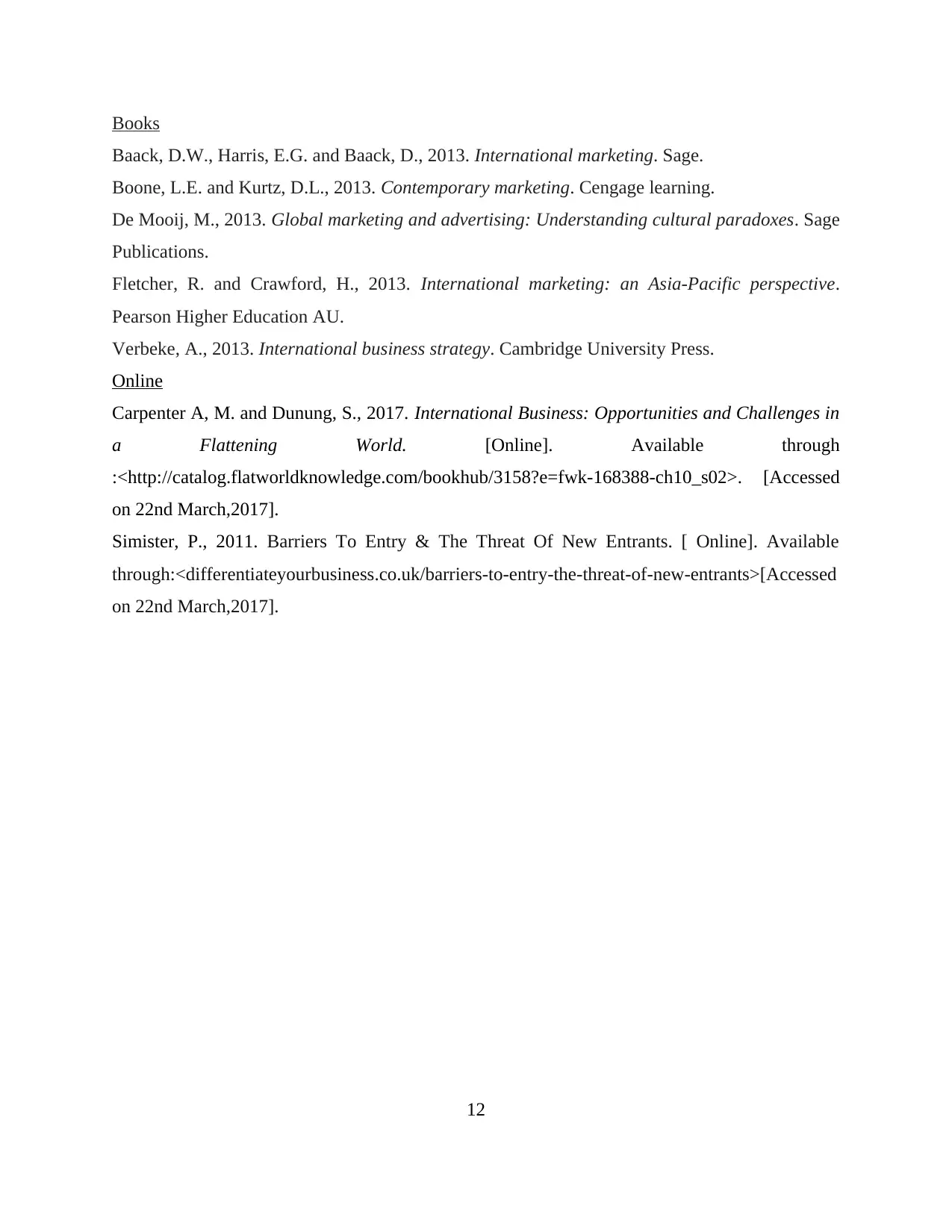
Books
Baack, D.W., Harris, E.G. and Baack, D., 2013. International marketing. Sage.
Boone, L.E. and Kurtz, D.L., 2013. Contemporary marketing. Cengage learning.
De Mooij, M., 2013. Global marketing and advertising: Understanding cultural paradoxes. Sage
Publications.
Fletcher, R. and Crawford, H., 2013. International marketing: an Asia-Pacific perspective.
Pearson Higher Education AU.
Verbeke, A., 2013. International business strategy. Cambridge University Press.
Online
Carpenter A, M. and Dunung, S., 2017. International Business: Opportunities and Challenges in
a Flattening World. [Online]. Available through
:<http://catalog.flatworldknowledge.com/bookhub/3158?e=fwk-168388-ch10_s02>. [Accessed
on 22nd March,2017].
Simister, P., 2011. Barriers To Entry & The Threat Of New Entrants. [ Online]. Available
through:<differentiateyourbusiness.co.uk/barriers-to-entry-the-threat-of-new-entrants>[Accessed
on 22nd March,2017].
12
Baack, D.W., Harris, E.G. and Baack, D., 2013. International marketing. Sage.
Boone, L.E. and Kurtz, D.L., 2013. Contemporary marketing. Cengage learning.
De Mooij, M., 2013. Global marketing and advertising: Understanding cultural paradoxes. Sage
Publications.
Fletcher, R. and Crawford, H., 2013. International marketing: an Asia-Pacific perspective.
Pearson Higher Education AU.
Verbeke, A., 2013. International business strategy. Cambridge University Press.
Online
Carpenter A, M. and Dunung, S., 2017. International Business: Opportunities and Challenges in
a Flattening World. [Online]. Available through
:<http://catalog.flatworldknowledge.com/bookhub/3158?e=fwk-168388-ch10_s02>. [Accessed
on 22nd March,2017].
Simister, P., 2011. Barriers To Entry & The Threat Of New Entrants. [ Online]. Available
through:<differentiateyourbusiness.co.uk/barriers-to-entry-the-threat-of-new-entrants>[Accessed
on 22nd March,2017].
12
⊘ This is a preview!⊘
Do you want full access?
Subscribe today to unlock all pages.

Trusted by 1+ million students worldwide
1 out of 12
Related Documents
Your All-in-One AI-Powered Toolkit for Academic Success.
+13062052269
info@desklib.com
Available 24*7 on WhatsApp / Email
![[object Object]](/_next/static/media/star-bottom.7253800d.svg)
Unlock your academic potential
Copyright © 2020–2025 A2Z Services. All Rights Reserved. Developed and managed by ZUCOL.





